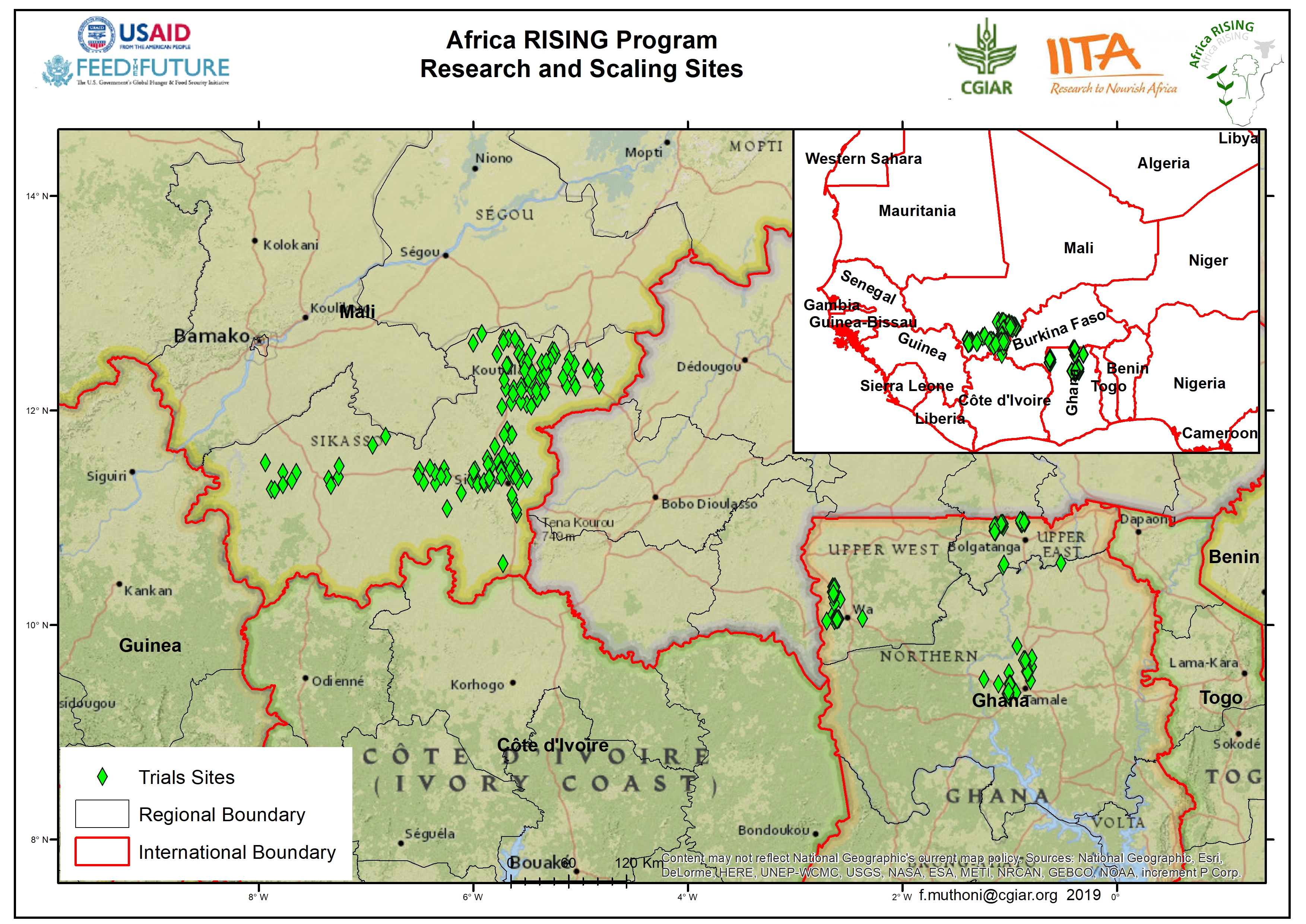The project is operating in the Guinea and Sudano−Sahelian zones of northern Ghana and southern Mali. In Phase 1 (2011–2016), research activities aimed at establishing the best-bet technologies that would deliver adoptable development solutions to smallholder farm families were tested and validated through participatory research approaches together with the farming communities. Phase 2 of the project (2016−2021) will combine continuity with evolutionary change to ensure that the technologies identified in Phase 1 drive wider adoption at scale through effective development partnerships. The project envisions that, by 2021, over 100,000 smallholder farm households in Ghana and Mali will benefit from Africa RISING technologies.
Based on the experiences and lessons learned from Phase 1, expected outcomes of the Africa RISING West Africa Project in Phase 2 are:
- Outcome 1: Farmers and farming communities in the project area are practicing more productive, resilient, profitable, and sustainably intensified crop–livestock systems linked to markets.
- Outcome 2: More farmers and farm families are adopting technologies and practices to improve nutrition, food and feed safety, postharvest handling, and value addition.
- Outcome 3: Farmers and other value chain actors have greater and equitable access to production assets and markets (input and output) through enabling institutions and policies.
- Outcome 4: Effective partnerships are built with farmers, local communities, and research and development partners in the private and public sectors to ensure delivery and uptake at scale of sustainable intensification technologies, innovations, and practices.
The farming systems in the Guinea and Sudano-Sahelian zones of West Africa are dominated by small-scale, resource poor farmers whose livelihoods depend on rain-fed crop, livestock, and crop livestock farming systems. The main staple crops are cereals (maize, rice, sorghum, pearl millet), and legumes (groundnut, cowpea, soybean, Bambara nut, pigeon pea).
Cereals are either grown in pure stands or intercropped/ rotated with legumes and a variety of vegetables. Crop yields on farmers’ fields are generally poor due to variable rainfall, declining soil fertility, use of low yielding crop varieties, almost non-existent mechanization, high cost of inputs, postharvest losses, labor constraints that lead to poor growing conditions (late sowing, suboptimal plant populations, inadequate control of pests and weeds, particularly Striga), and low use of organic or mineral fertilizers.
Cattle, sheep, goats, pigs, chicken, guinea fowl, turkeys, and ducks are reared for meat, milk, land preparation, transport, manure, and cash. The animals are mostly managed under extensive and semi-intensive systems with limited feed, shelter, health care, and breeding management. Productivity of the animals is low due to seasonal shortages in quality feed and watering points linked to degradation of the environment. Improved livestock breeds are also not very accessible to farmers while commercial feeds are expensive and thus unaffordable. Farmers in this farming system are also confronted by high livestock mortality rates occasioned by limited access to veterinary services and inappropriate husbandry (feeding, health care, housing) practices.
In general, the crop and livestock enterprises are weakly integrated, and thus do not mutually reinforce each other. The diets of most rural poor farm families is often dominated by the intake of basic staple foods (e.g., maize, rice, millet, and sorghum) which are usually deficient in micronutrients such as vitamin A, iron, and zinc needed to prevent malnutrition. The nutritional status of most farm household
members, especially pregnant women, breastfeeding mothers, and children below 24 months of age, is therefore poor, leading to chronic malnutrition. Nearly 25% of children in the intervention communities in Ghana are reported to be stunted, underweight, and anemic with lifelong consequences. The causes for the inadequate diets lie in low income, unsuitable food processing, storage and feeding practices, and poor nutrition knowledge.
Farmers have difficulties in accessing input and output markets. Enabling institutions and policies are also lacking. Due to inadequacies of traditional promotional and scaling-up/out pathways, there is a large unmet demand for information about improved agricultural technologies and for access to the technologies themselves, especially by women. This has led to low adoption of improved technologies and best practices to reduce food insecurity, poverty, and natural resource degradation.
Through a participatory and demand-driven approach to research, project partners are implementing adaptive research on various technologies and working with development organizations to get them into the hands of farmers at scale. The activities include testing and disseminating: (i) improved crop varieties (drought and Striga resistant food and feed crops); (ii) appropriate agronomic practices (planting density, cereal−legume rotations and intercropping, multiple cropping, increasing cropping cycles within a season, efficient use of input resources and agroforestry); (iii) climate-smart land management practices (conservation agriculture, physical barriers to soil and water loss, in-situ water harvesting, and soil cover crops); (iv) improved animal husbandry practices (semi-intensive and intensive management); and (v) technologies for reducing pre- and postharvest losses. The project also facilitates linkages between farmers and input/ output markets. The objective is to build well-integrated and productive crop and livestock enterprises that minimize natural resource degradation.
To diversify household nutrition, the project is introducing new nutritious food preparation techniques based on locally available ingredients for household members, particularly children. Nutrition field schools are being used to promote knowledge exchange on best practices for processing and storage of cereals, legumes, and vegetable-based foods. Group and individual trainings are conducted to strengthen the capacities of all actors (farmers, research and extension staff, input and output dealers, and policy makers).
Academic training at the MSc and PhD level is applied to address important knowledge gaps, and to develop the “next” generation of scientists. Information exchange is being promoted through field days, radio programs, exchange visits, and video shows.
The project gives special attention to gender equality and underprivileged groups within the society. Enabling policies and institutions to improve access to input and output markets, formation of effective partnerships, and access to knowledge and information are advocated for, especially through operational level R4D/Innovation platforms.
[wm_website_map id=”5″]


